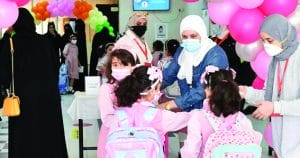One of the first lessons I had as a class teacher was Behavior, which is a form of communication. One of my most notable learning moments was when one of my students (usually quiet and hardworking) refused to complete his homework. I was frustrated at first, and soon I asked him a simple question. He is non-judgmental (what’s going on?) He replied that his mother had recently become seriously ill.
Teachers often read students’ unusual and out-of-the-ordinary actions as misbehavior or disrespect but they actually reflect something deeper to us about them, such as personal challenges, mistrust, social conflicts and their emotional effects in their surroundings, and more. What teachers usually do to deal with these acts is to activate (punishment), which is the prevailing classroom management tool in our schools, but by doing so, we have helped to exacerbate the results of these underlying causes, which leads to the rupture of relations between the teacher and his students and to an increase in the state of conflict experienced by the student himself.
(restorative justice) It means holding wrongdoers accountable for their actions, understanding the harm they have caused, and being given a chance to redeem themselves and stop this behavior. On the other side, the goal of restorative justice is to give them a role in the process and to reduce their feelings of anxiety and helplessness. It is a philosophy and approach to address conflict rooted in relationships, reform, and accountability, as it calls on teachers to move away from punishments and focus on consolidating the relationship with students and building trust through various activities. Restorative justice actually offers us the ability to understand the underlying causes of all unwanted behaviors that students perform or Even the problems they make and work to fix.
During the school year (2021/2022), I was fortunate enough to work as a restorative justice coordinator at a middle school. This role taught me a tremendous amount about the power of restorative practices and how they can support and develop a healthier school community, both in and out of the classroom.
- Teach students how to manage their own conflicts.
Teachers often understand their roles primarily as teaching students our academic content. However, there is much more that we teach our students outside of our curriculum. For example, when we only resort to sanctions as a solution to conflict and disagreements, what are we teaching our students about how to deal with conflict in their lives, now and as adults in the future?
Moreover, when we resolve conflicts for our students instead of giving them opportunities to do so, we deny them an enormous educational opportunity. In the case of bullying, for example, instead of simply punishing the student who caused harm, we can invite the students involved into a restorative circle. Through this process, we can more deeply understand the causes of this conflict, and the needs of the bullied student, and students can co-create solutions moving forward. Hence, gaining these experiences teaches students strategies to deal with conflicts on their own!
When I ran circles among students involved in bullying, the insights were always helpful: Sometimes we learn that the student who bullied had peer pressure, low self-esteem, or anger issues, other times, we learn that the student who was bullied sometimes contributed Explicitly and sometimes unintentionally in the causes of conflict. Without understanding and addressing these core issues, we will not fully solve the problem.
Imagine with me that students from the primary level engage in age-appropriate conflict resolution activities, imagine how the school culture and students’ relationships with each other and with their teachers can flourish!
- Improving employee culture.
Restorative justice is not just about resolving conflicts between teachers and students. Schools that take a holistic approach to conflict resolution actually foster a strong ethical culture for their staff. By using restorative justice only to address conflicts with students rather than with fellow teachers, we not only continue to harm school culture, but we delegitimize restorative justice as a method of conflict resolution.
One of the simple actions I took when I was a restorative justice coordinator was to start every teacher meeting with an opening circle. These circles allowed teachers, especially those who don’t often work together, to slow down from the fast pace of work, learn more about their colleagues, and build new relationships based on shared interests.
As a school principal, it is important to think of restorative justice as not just a classroom transformation, but a schoolwide transformation. How can we use tools such as meetings and dialogue sessions to mediate conflicts between teachers? Addressing this question can help support a healthier school culture, which can improve teacher morale and student experiences at school.
Matt Knelling / Head of Department at Detroit School – United States




